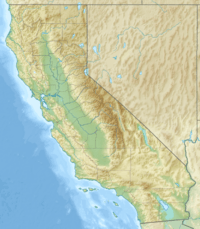San Mateo Peak facts for kids
Quick facts for kids San Mateo Peak |
|
|---|---|

San Mateo Peak seen from the northeast at Morgan Trail-head.
|
|
| Highest point | |
| Elevation | 3,591 ft (1,095 m) |
| Listing | Sierra Club, Lower Peaks Committee |
| Geography | |
| Location | Riverside County, California, U.S. |
| Parent range | Elsinore Mountains, Santa Ana Mountain Range |
| Topo map | USGS Sitton Peak, CA |
| Geology | |
| Mountain type | Granitic |
| Climbing | |
| Easiest route | Hike class 1 |
San Mateo Peak is a tall mountain in the Elsinore Mountains. It is part of the larger Santa Ana Mountain Range in California. This peak stands at about 3,591 feet (1,095 meters) high.
Even though it's the highest point in the Elsinore Mountains, San Mateo Peak doesn't have an official name. People often call it by this name because of the efforts of a group of hikers.
Discover San Mateo Peak
San Mateo Peak is located in Riverside County, in the sunny state of California. It sits at the western end of a long, high ridge. This ridge stretches from Elsinore Peak towards Morrell Canyon.
The mountain is a key part of the Elsinore Mountains. It is even taller than the nearby Elsinore Peak, which is officially named. Elsinore Peak is about 3,536 feet (1,078 meters) tall.
Who Named This Mountain?
The name "San Mateo Peak" was first suggested by Ken Croker. He was a guide for the Sierra Club Lower Peaks Committee. For 20 years, Ken worked hard to maintain hiking trails in the Santa Ana Mountains. He did this with help from other volunteers from the Sierra Club.
Because of their work and the peak's importance, the Sierra Club adopted the name. Even without an official government name, it is widely known as San Mateo Peak. This shows how much hikers and nature lovers care about the area.
Where Rivers Begin
San Mateo Peak is an important source for several local waterways. One of these is San Mateo Creek. This creek starts on the western side of the peak, at an elevation of about 2,800 feet (853 meters).
Another important stream, a branch of Morrell Canyon Creek, begins on the northeast side of the peak. Several smaller streams, called arroyos, also flow down from the peak. These arroyos eventually join Morrell Canyon Creek. An arroyo is a dry creek bed that fills with water only after heavy rain.
On the southwest side of the peak, another unnamed arroyo starts. This arroyo also flows into San Mateo Creek. These waterways are vital for the local environment and wildlife. They carry water through the landscape, supporting plants and animals.


